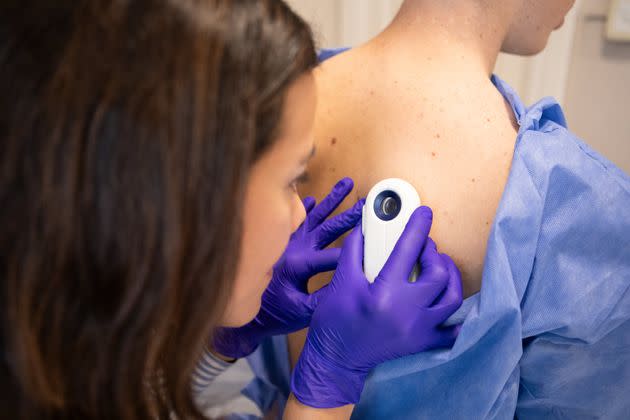Melanoma Skin Cancer Is At An All Time High In The UK, These Are The Signs To Look For

Melanoma is a type of skin cancer that can spread to other parts of the body and according to Cancer Research UK (CRUK), there will be a record 20,800 cases diagnosed this year – up from a yearly average of 19,300 between 2020 and 2022.
Analysis from the charity also shows that almost nine in 10 cases of melanoma are caused by too much ultraviolet (UV) radiation.
The Skin Cancer Foundation states: “Malignant melanoma is a serious form of skin cancer that begins in cells known as melanocytes.
“While it is less common than basal cell carcinoma (BCC) and squamous cell carcinoma (SCC), this skin cancer is more dangerous because of its ability to spread to other organs more rapidly if it is not treated at an early stage.”
The signs of melanoma to look out for
According to Cancer Research UK, doctors use a checklist which explains some of the signs of melanoma to look out for. It’s called the ABCDE list.
A - asymmetrical
Melanomas are likely to have an uneven shape. The two halves may be different shapes or sizes, making them asymmetrical.
Normal moles usually have a more even shape and the two halves are similar, making them symmetrical.
B - border
Melanoma moles are more likely to have irregular edges that are blurry or jagged.
Normal moles tend to have a smooth, regular border.
C - colour
Melanomas tend to be uneven in colour and have more than one shade. CRUK said: “A melanoma might have different shades of black, brown and pink.
“Normal moles usually have an even colour. If they have 2 colours in them, the colours are normally symmetrical across the 2 halves.”
D - diameter
Usually, melanoma moles and patches of skin are more than 6mm wide. Normal moles are about the size of the end of a pencil or smaller.
E - evolving
CRUK said: “Evolving means changing.
“Melanomas might change in size, shape or colour. Or you might notice other changes such as:
bleeding
itching
a change in sensation to a mole or area of abnormal skin
a mole becoming crusty
“Most melanomas don’t give you symptoms like pain or itching. And some non cancerous (benign) moles or abnormal patches of skin can be itchy. So having some of these changes on their own doesn’t mean you definitely have melanoma. But you should still get it checked. ”
When to see your GP
The NHS recommends that if you spot any of these symptoms, you should book an appointment with your GP as soon as possible:
you have a mole that’s changed size, shape or colour
you have a mole that’s painful or itchy
you have a mole that’s inflamed, bleeding or crusty
you have a new or unusual mark on your skin that has not gone away after a few weeks

